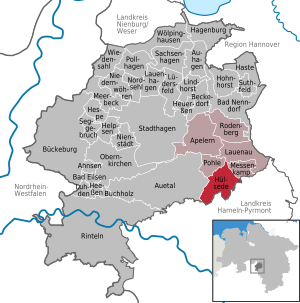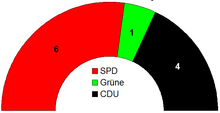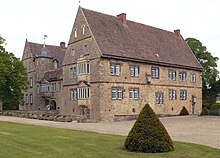Hülsede
| coat of arms | Germany map | |
|---|---|---|

|
Coordinates: 52 ° 15 ' N , 9 ° 22' E |
|
| Basic data | ||
| State : | Lower Saxony | |
| County : | Schaumburg | |
| Joint municipality : | Rodenberg | |
| Height : | 103 m above sea level NHN | |
| Area : | 15.85 km 2 | |
| Residents: | 1054 (Dec. 31, 2019) | |
| Population density : | 66 inhabitants per km 2 | |
| Postal code : | 31867 | |
| Area code : | 05043 | |
| License plate : | SHG, RI | |
| Community key : | 03 2 57 017 | |
| Community structure: | 3 districts | |
| Association administration address: | Amtsstrasse 5 31552 Rodenberg |
|
| Website : | ||
| Mayoress : | Marion Passuth ( SPD ) | |
| Location of the municipality of Hülsede in the Schaumburg district | ||
Hülsede is a municipality in the southeast of the district of Schaumburg in Lower Saxony . The community has over 1000 inhabitants and is part of the Rodenberg community .
geography

location
Hülsede is located on the northeast slope of the Süntel in the Deister-Süntel valley . The Hülseder Bach (local Beeke) flows through the village in a largely piped brook bed and shortly afterwards flows into the Rodenberger Aue .
Districts
The municipality of Hülsede consists of the following districts:
- Hülsede with the residential areas Mittelmühle and Niedermühle
- Mean
- Schmarrie with the residential areas Bussenmühle, Eisenhammer, Herriehausen and the Pulvermühle
Neighboring communities
In a clockwise direction , neighboring communities are Auetal , Pohle and Messenkamp and the towns of Bad Münder and Hessisch Oldendorf .
history
Old names of the place are around 1223 Hulsede, 1300 Hulsedhe, 1352 to Hulsede, 1492 Hulsede, 1518 tho Hülssde, 1527 to Hülssede, 1533 Hulszede, 1620 Hülßde and 1647 Hülssende.
The first reference to the village is contained in the registers of goods of the imperial abbey of Fulda, written around 1150. It is noted that a Duke Bernhard in "Hulside" two courtyards (mansi) were given to fief. This note most likely refers to the time of the Billung dukes Bernhard I († 1011) or Bernhard II of Saxony († 1059), with historians suspecting the latter. The municipality of Hülsede has so far related its village anniversaries to the year of his death in 1059. Earlier reference years (e.g. 1012, the beginning of the reign of Bernhard II of Saxony) do not seem to be excluded.
In 1310 the churchyard, the middle mill and the high courtyard were first mentioned in a document. The manor mill from 1450 is one of the oldest watermills in Lower Saxony. From 1474 the Baake family ran a forge in Hülsede. Hülsede owned brewing rights , and Carsten Eckermann is named as the last brewer. The last miller in Hülsede was Otto Habermann. In 1944, Celtic urns were found near the high court.
The Hülsede carpenter's cooperative was the nucleus of the furniture industry in the Deister-Süntel valley.
In 1978 a NATO depot was built on the Westeregge , which was closed in 1993.
On March 1, 1974, the communities Meinsen and Schmarrie were incorporated.
Schmarrie was first mentioned as Smeringe around 1230. East of Schmarrie there was a small moated castle with the Posteburg at the end of the 14th and beginning of the 15th century in a lowland area on the Rodenberger Aue , on which a nobility family presumably sat. Meinsen was founded according to an uncertain document between 780 and 802. Herriehausen was first mentioned in 1346 in the Fischbeck document book as Herdingehusen and was owned by the Fischbeck Monastery . All districts belonged to the dissolved district of Springe until March 1, 1974 and were incorporated into the district of Grafschaft Schaumburg .
Since August 1, 1977, the municipality of Hülsede has belonged to the newly formed district of Schaumburg .
politics
Municipal council
The council of the municipality of Hülsede consists of eleven council women and councilors. This is the specified number for the member municipality of an integrated municipality with a population between 1001 and 2000 inhabitants. The council members are elected for a five-year term by local elections. The current term of office began on November 1, 2016 and ends on October 31, 2021.
The last local election on September 11, 2016 resulted in the following:
| Political party | Proportional votes | Number of seats |
|---|---|---|
| SPD | 46.52% | 5 |
| CDU | 27.65% | 3 |
| WHG | 20.71% | 2 |
| GREEN | 5.09% | 1 |
The turnout in the 2016 local elections was 71.92%, above the Lower Saxony average of 55.5%.
mayor
Marion Passuth ( SPD ) has been mayor since November 9, 2011 . Martin Schellhaus has been the community director since 2016.
coat of arms
In silver three green leaves of holly and three fruits in the middle in a triangle.
Culture and sights
Architectural monuments
- Ev.-luth. Parish church of St. Aegidien , built in the first half of the 15th century on the remains of a previous church as a quarry stone building. The ceiling paintings by Minden master Jürgen Dove from 1577 were extensively restored in 2013. In addition to the church, the rectory from 1810 and a former barn are also under monument protection.
- Hülsede moated castle in the Renaissance style in the Weser area ( Weser Renaissance ), built 1529–1548. In addition to the castle, the graft and the landscape park as well as two stables, two barns and a residential building (former court master's apartment) also belong to the ensemble, which is under monument protection.
- Manor mill. It is one of the oldest watermills in Lower Saxony and is mentioned in the 2008 Red and White Map. Not only the mill, but also the house is a listed building.
- The Mittelmühle with the residential part, a residential building extension and a barn has been in the list of architectural monuments since 2009.
- The barn of the Niedermühle is listed as a historical monument.
- The entire courtyard of Herriehausen 1 with the main house, breeding, adjoining house and mill is under protection.
- In Hülsede the residential and farm building “Über der Beeke 12” (Schmiede Baake) is listed as a historical monument.
- The residential and farm building is also listed as “In der Rehre 18”.
- The war memorials in Hülsede and Schmarrie as well as the former school in Hülsede are listed.
- In Meinsen, at 8 Cloppenburg Street, there is a former blacksmith's shop with a weir and pond, and at Meinser Straße 6, a residential and farm building is under monument protection.
- A group of buildings at Meinser Straße 22, consisting of a residential building, two barns and a stable, are shown as an example of a late 19th century courtyard.
- Courtyards at Schmarrier Strasse 4, 24, 26 and 28 are listed with several residential buildings and ancillary buildings. Likewise in No. 29 a former granary. At corner 2 it is a residential and farm building.
- The historic site of the Eisenhammer hammer mill with its structural remains and the residential and farm building complex is of importance in terms of monument preservation.

Natural monuments / landscape protection
- At the Hülseder Bach is the natural monument Krüppelbuche , a 200-year-old Süntelbuche . It's just a dying tree since it was damaged while felling trees in 2001. There are eight more of these rare trees in the area. Four of them are behind the war memorial on the edge of the forest on Westeregge. In 1843, 600 acres of Süntel beech trees were cleared here. The wood was processed into charcoal in piles because of its many bends and bumps. The rest of them fell victim to slash and burn.
- The Kehen Brink ski slope on the edge of the Süntelrand is protected as a natural monument because of the orchids that grow there.
- In Schmarrie, a group of oaks that had been felled in the meantime was protected as a natural monument.
- Some parcels from all districts belong to the Süntel nature reserve.
- According to the landscape framework plan, the Nordsüntel and the Meinser Bach meet the requirements for a nature reserve. A NSG Nordsüntel is required in the NHB's red folder.
archive
The archive of the municipality of Hülsede is located in the state archive of Bückeburg as a deposit of the joint municipality of Rodenberg .
Economy and Infrastructure
The next motorway junction is Lauenau on federal motorway 2 Hanover - Dortmund . The B 442 runs north-east of the community and runs from Bad Münder to Wunstorf . A connection to the local public transport exists through the Schaumburger Verkehrsgesellschaft and through the call car of the municipality of Rodenberg. The nearest train stations are in Bad Nenndorf , Bantorf and Bad Münder .
With 20 employees, Heine-Sitzmöbel in Hülsede is the last of what used to be over 40 furniture factories in the Deister area. The buildings of the Kracke furniture factory, which was closed in 2016, are used as the Hülsede business park. A biogas plant is operated on the Westeregge in the former NATO depot.
- The Bad Nenndorf police station is responsible for public safety and order with a police station on day duty in Lauenau.
- Defensive fire protection and general help are provided by the Hülsede-Meinsen and Schmarrie volunteer fire departments .
Elementary school students attend the school in Lauenau. Secondary schools are located in Rodenberg, Bad Nenndorf and Stadthagen.
Personalities
- Wilhelm Blumenberg (1863–1949), pastor in Hülsede from 1889 to 1904, then pastor of the Aegidienkirche in Hanover for many years . His son Werner Blumenberg (1900–1965) was born in Hülsede , who later became a social democratic journalist and resistance fighter.
- Hans-Joachim Thormann (1917–1979), village school teacher and headmaster of the elementary school in Hülsede, sports functionary, local politician, member of the district council, deputy district administrator, holder of the Lower Saxony Order of Merit, 1st class.
Web links
Individual evidence
- ↑ State Office for Statistics Lower Saxony, LSN-Online regional database, Table 12411: Update of the population, as of December 31, 2019 ( help ).
- ^ Jürgen Udolph (research): The "place name researcher". (No longer available online.) In: Website NDR 1 Lower Saxony . Archived from the original on November 27, 2015 ; accessed on August 4, 2019 .
- ↑ Hülsede local walk. In: spurensuche.schaumburgerlandschaft.de.
- ↑ NATO Depot Hülsede. In: hoefingen.net. Retrieved October 9, 2016.
- ^ Federal Statistical Office (ed.): Historical municipality directory for the Federal Republic of Germany. Name, border and key number changes in municipalities, counties and administrative districts from May 27, 1970 to December 31, 1982 . W. Kohlhammer, Stuttgart / Mainz 1983, ISBN 3-17-003263-1 , p. 202 .
- ^ Lower Saxony Municipal Constitutional Law (NKomVG) in the version of December 17, 2010; Section 46 - Number of Deputies. Retrieved March 29, 2017.
- ^ Council of the community of Hülsede. Retrieved November 28, 2016.
- ↑ a b Municipality of Hülsede - overall results of the 2016 municipal council elections. Accessed on March 29, 2017.
- ↑ The CDU gets the most votes nationwide. In: Website Norddeutscher Rundfunk . September 12, 2016. Retrieved March 29, 2017 .
- ↑ www.sn-online.de Passuth remains mayor. November 9, 2016. Retrieved November 28, 2016.
- ↑ List of architectural monuments according to § 3 NDSchG (as of December 5, 2011)
- ↑ Hülsede moated castle
- ^ Ordinance on the protection of parts of the landscape in the Springe district of September 17, 1968
- ↑ www.sn-online.de: A saw for Hülsede. August 14, 2017, accessed June 16, 2018.









